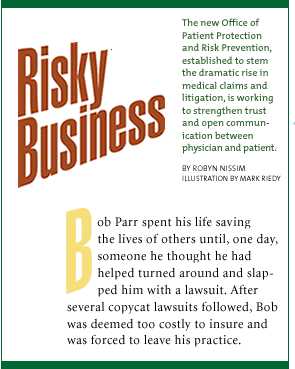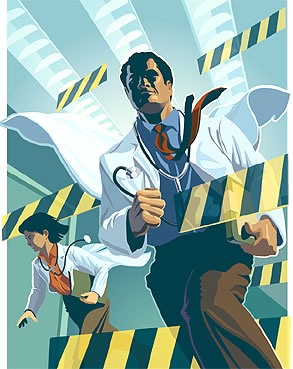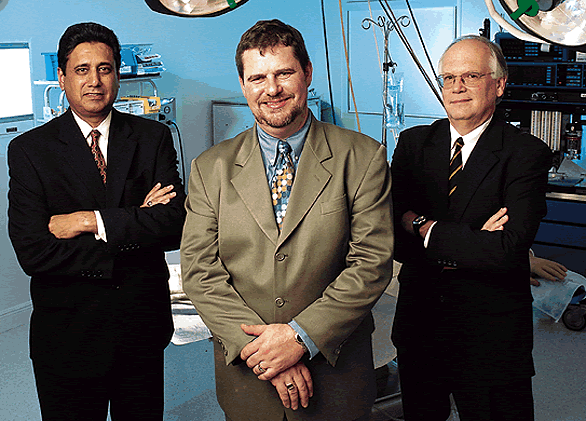 |
 |
|
Movie fans might recognize
Bob Parr as the protagonist of Disney’s hit film, The Incredibles,
who early on in the picture was sued out of the superhero business. He
spends many unhappy years as a civilian until the public realizes they
need superheroes, and he becomes Mr. Incredible again.
Superheroes are not physicians, and physicians are not superheroes. But you could easily substitute a doctor for the well-intentioned Mr. Incredible. Physicians typically go into medicine because they want to help people. Many will also tell you, however, that in the current litigious climate they often feel estranged from their patients, distracted by paperwork, and plagued by red tape and mutual distrust. When asked to identify the best way to overcome these barriers, both doctors and patients will say that what they truly desire is an opportunity to rebuild the trust and mutual concern that are the hallmarks of the provider-patient relationship. The University of Miami Leonard M. Miller School of Medicine has formed the Office of Patient Protection and Risk Prevention to help achieve that goal.
![]() he
office’s mission: Put together a team that
will live up to its new name—one that prevents risk, protects patients,
and changes the system for the better of patients and practitioners. “We
feel that as an academic medical center, we can leverage our high-quality
faculty and staff, and our broad academic and scientific resources, to
create programs that not only better manage risk and promote the effective
handling of claims, but also result in better patient outcomes,” says
Steven Stark, executive director of the Office of Patient Protection
and Risk Prevention.
he
office’s mission: Put together a team that
will live up to its new name—one that prevents risk, protects patients,
and changes the system for the better of patients and practitioners. “We
feel that as an academic medical center, we can leverage our high-quality
faculty and staff, and our broad academic and scientific resources, to
create programs that not only better manage risk and promote the effective
handling of claims, but also result in better patient outcomes,” says
Steven Stark, executive director of the Office of Patient Protection
and Risk Prevention.
Recent studies have found that one of the most effective responses to the malpractice crisis is to change the way doctors communicate with patients and families. One of the primary goals of the Office of Patient Protection and Risk Prevention is to give back control of the relationship to the people who can best maintain it—the doctor and the patient. “Physicians and patients alike need to engage in some behavior modification. We need to remember that patients are our customers and patients need to remember that we are their caregivers. When you re-establish that rapport, you have a better chance of enhancing the recovery of those patients,” says Jorge R. Guerra Jr., M.D., professor of radiology and chairman of the University of Miami Medical Group Governing Board.
 |
|
A few years ago the Miller School of Medicine realized that while the number of malpractice claims had stayed steady over a long period of time, the severity of the claims, jury verdicts, and the cost of settling cases were steadily and inexorably rising. According to Stark, then an attorney with Fowler White Burnett, one of the primary outside counsels for the Miller School, the annual cost of litigation essentially doubled.
As a result, the school’s administration commissioned an outside consulting group to study their claims handling, litigation, and risk management strategies. At the time, claims against the University were handled through a joint risk management arrangement with Jackson Memorial Hospital. Although Jackson, a public hospital owned and controlled by the Public Health Trust, has sovereign immunity protection and statutory damage caps for any claims brought by its patients, it also faced a growing financial crisis. That limited its ability to implement changes that both UM and Jackson believed were necessary to continue their academic and public health efforts on behalf of Miami-Dade County.
The Miller School, which had for many years absorbed a disproportional cost of litigation and medical negligence claims, recommended that an office be created to address the claims handling, risk prevention, and patient protection activities of the school’s faculty practice and the University-owned hospitals. The new office would work closely with the recently established UM/Jackson Center for Patient Safety and coordinate the development of additional programs focused on the needs of its faculty physicians and their patients.
Last fall Stark left his 20-year career with Fowler White Burnett and joined the Miller School of Medicine to run the new office. Joining him in this mission are Farooq Shafi, Keith Lindloff, and Wendy Kverne. Other data management and analysis staff, litigation management personnel, and people to facilitate provider-patient interactions will soon be added. Like the faculty and staff of the Center for Patient Safety, this team is also focused on searching for ways to improve communication, to enhance systems, and to take whatever steps are necessary to change the traditional focus away from simply managing incidents toward a system that works proactively to prevent them.
In some instances, the change might be a simple one. In 2002 the hospitals in the University of Michigan Health System began encouraging doctors to acknowledge and apologize for their mistakes. They’ve seen malpractice lawsuits and notices of intent to sue drop significantly.
The risk prevention team at the medical school feels that simply improving communication could have an impact here as well.
Lindloff, who joined the Miller School in December after serving as director of risk management for Texas Children’s Hospital, says, “When you deliver the level of care that gets delivered at the University of Miami/Jackson Memorial Medical Center—we’re talking about complex cases and a huge facility—it can be a bewildering place. And people get intimidated by the size and complexity of what’s going on; they get intimidated and worried by the fact that they’re sick. As a result, they don’t often ask questions, they may not know what’s going on, and they may have expectations that are unrealistic.
“If we can keep them better informed, on the front end or if an event occurs, we can communicate quickly and candidly with the family afterwards and we might be able to preserve the relationship,” Lindloff adds. “We then have a chance, a real good chance, of resolving any issues. We know that there will always be claims work to do. But we think that we can reduce that amount and maybe make some of the ones that might otherwise be really, really severe much less severe.”
![]()
There’s already proof that the system can work. In the first six weeks that Stark was at the Miller School, he and various team members were successful in preventing at least two cases from going to court by promoting open discussion and admission of errors where errors had indeed happened. “We try to be transparent with our disclosure as we talk to patients and families,” Stark says. “Ultimately, if it’s a case that we believe was the result of some sort of medical error or medical mishap and that the patients are entitled to some form of compensation, then we try to do that. We try to sit down with the patient, tell them we were sorry, explain that we understand what they were going through, and come to an understanding on reasonable compensation.
“Every medical malpractice case is a story. And professionals need to recognize that telling the story is an important component of the healing process for our patients because money does not bring back lost limbs or loss of loved ones,” Stark adds.
“Our position is that full and open disclosure is not only already required by AMA guidelines, required by federal law, required by the Joint Commission on Accreditation of Health Care Organizations, and now required by state law, but it is simply the right and ethical thing to do.”
![]() tark and his team want to focus on rebuilding the
relationship between physician and patient, which means not only minimizing
the potential for lawsuits but also
improving systems to reduce errors. “Having represented physicians in civil
actions and before juries and courts, as well as representing physicians before
licensing boards for 20 years, I can assure you that physicians are as affected
emotionally as patients and families are when there are bad outcomes or unanticipated
complications. They all believe that they have not done enough,” Stark
says.
tark and his team want to focus on rebuilding the
relationship between physician and patient, which means not only minimizing
the potential for lawsuits but also
improving systems to reduce errors. “Having represented physicians in civil
actions and before juries and courts, as well as representing physicians before
licensing boards for 20 years, I can assure you that physicians are as affected
emotionally as patients and families are when there are bad outcomes or unanticipated
complications. They all believe that they have not done enough,” Stark
says.
“If we want a system that truly works, then we need to make sure that there are also systems in place to allow physicians to do their best to maximize outcomes. Medicine is extraordinarily complex. To think that a physician or a provider has to remember every single disease process, have read every single article, or know all of the new methods or techniques that are available, and then apply all of that knowledge and a healthy dose of medical judgment to a fairly tense, often brief interaction with the patient, and come up with the right answer all the time, is just a denial of the limits of human ability and the intricacies of human nature.”
Working with the Center for Patient Safety, facility risk managers, and clinical investigators, the risk prevention team is going to spend the next few months gathering and analyzing all sorts of information, from ergonomics to surgical procedures, in order to see where and when mishaps occur, as well as track what Stark calls work-arounds. Once the information is gathered, the team will identify trends, assess that information, and go to work on bolstering weak areas.
“Is any of this going to work? I don’t know,” Stark admits. “But I gave up a 20-year practice because I believe now is the time when we can make a difference. It’s time to take back control of the most important relationship in health care, for the profession to step in and say, ‘We understand your fears, and now we’re going to fix it.’
“We need to put back into medicine what is the most important—the physician and the patient,” Stark says. Free physicians from the fear, anger, and frustration that they feel now and they can go back to saving lives. Just like Mr. Incredible.
Robyn Nissim is the editor of Miami Medicine. Photo by Paul Morris.
![]()